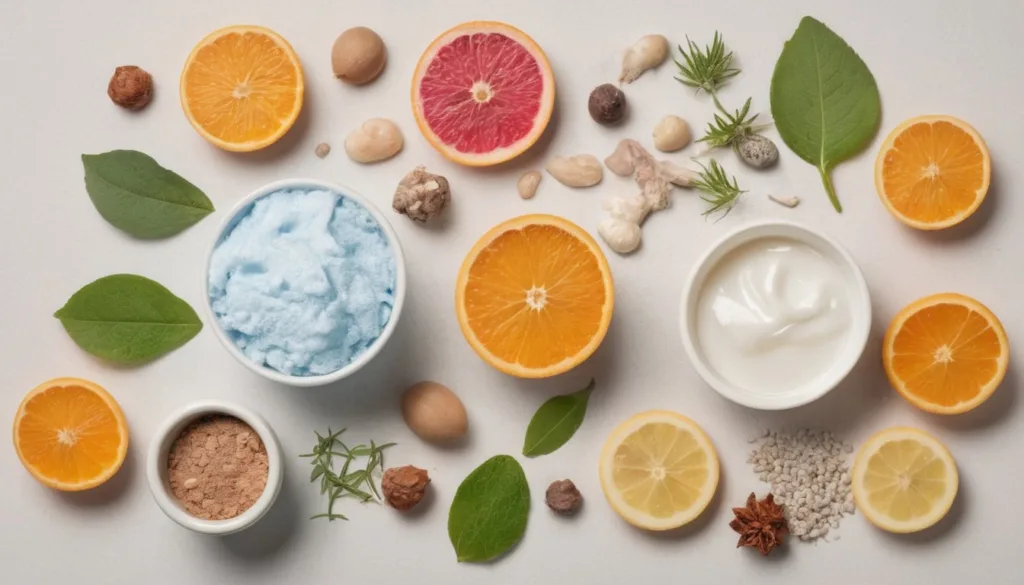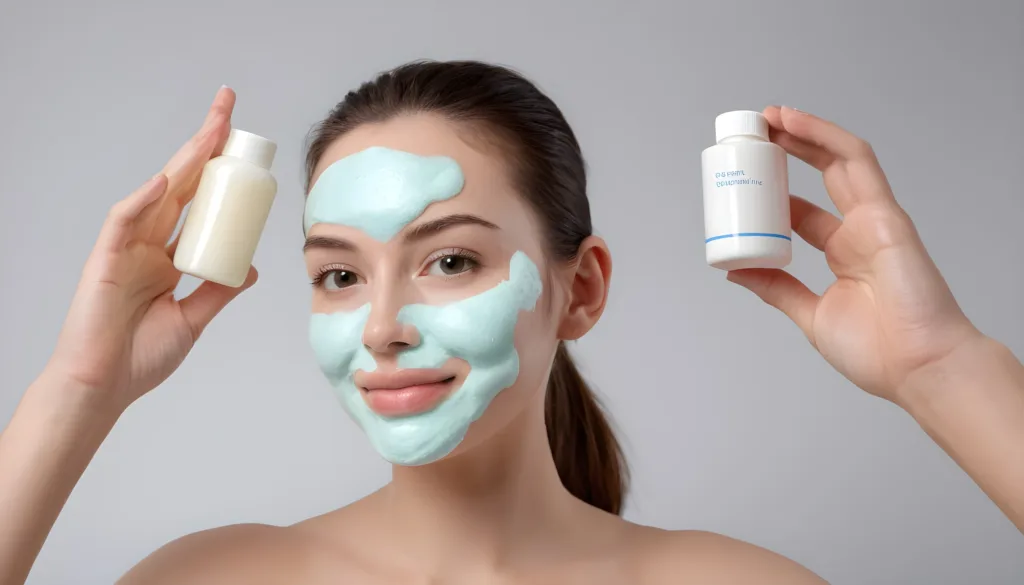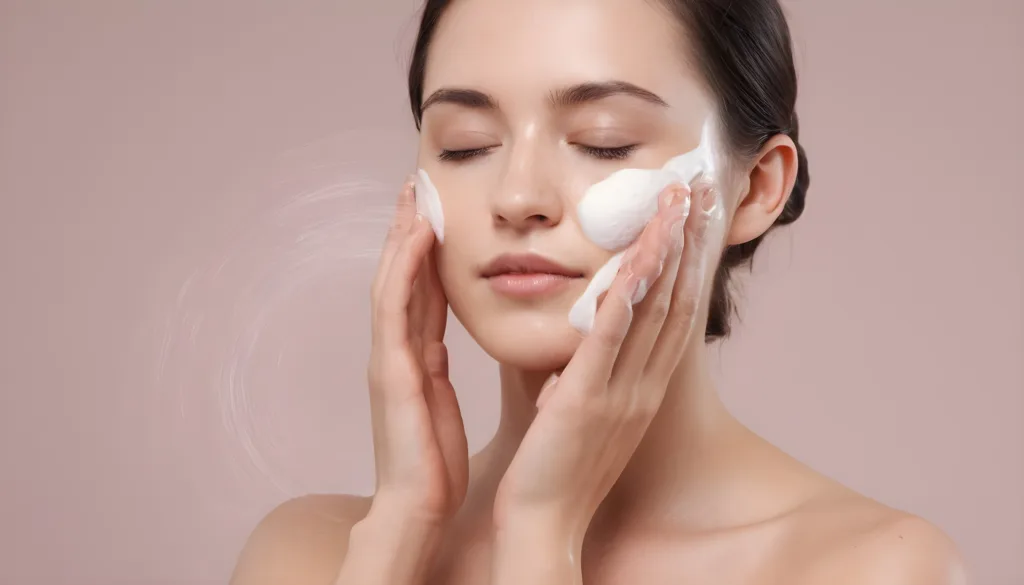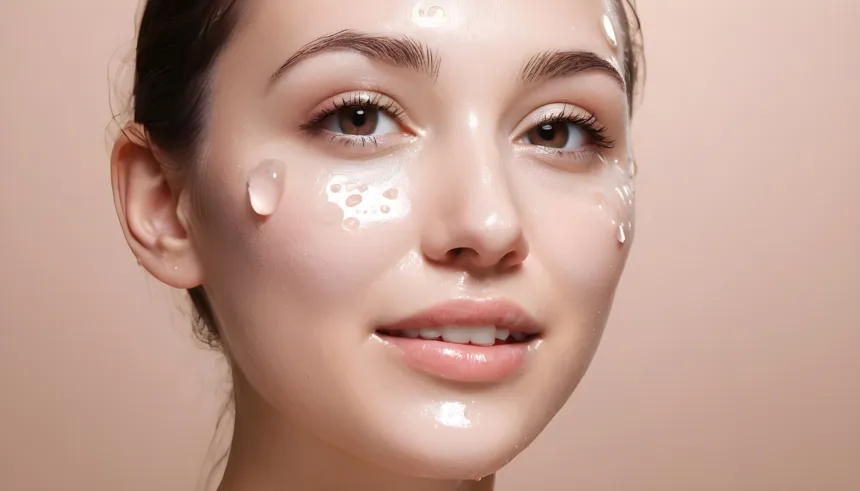Have you ever caught a glimpse of yourself in the mirror and wondered, “What happened to my skin?” I sure have. It was a typical morning rush – alarms blaring, coffee brewing, and me trying to piece together some semblance of a presentable face.
But as I leaned in closer, I couldn’t ignore the dullness staring back at me, the leftovers of yesterday’s makeup and dry patches clinging stubbornly to my pores. That’s when it hit me: is my facial cleanser too harsh?
Trust me, my bathroom counter was cluttered with an array of facial cleansers, each promising to work wonders on my skin and all I got was irritation, dryness, and even breakouts. But here’s the thing: despite my rocky journey, I’ve come to realize that a good facial cleansing plays in maintaining healthy skin. The right product and approach can truly make all the difference.
So, let’s find out how to know if cleanser is too harsh and why facial cleansing is not just important, but essential for achieving that radiant, clear complexion we all crave.
Table of Contents
Setting the Stage: The Importance of a Gentle Facial Cleansing Routine
Okay, so here’s the deal: our skin is like a shield, protecting us from all sorts of stuff out there – dirt, pollution, you name it. And just like any other skilled spy, it needs to recharge to stay strong and healthy. That’s where facial cleansing swoops in to save the day!
Facial cleansing is not just about washing away the dirt; it’s about giving your skin a fresh start, ready to take on whatever the day throws at it. Plus, it’s a great way to wake yourself up in the morning and wind down at night.
Harsh Cleansers and Their Potential Drawbacks
Now, here’s the twist: not all cleansers are created equal. Some of them can be a bit too harsh for our delicate skin. Imagine using a scrub that feels like an emery board on your face – yikes, right? These harsh cleansers might seem like they’re doing a good job at first, but they can actually cause more harm than good.
You see, harsh cleansers can strip away our skin’s natural oils, leaving it feeling dry, tight, and unhappy. And nobody wants that, right? And, they can irritate our skin, making it all red and angry. Not cool, cleansers, not cool.
So, before we peel back the layers of facial cleansing, let’s not forget one thing: gentle is the way to go. Our skin deserves the best, and we’re here to give it just that!
Understanding Facial Cleansing

Have you ever wondered why we have wash our faces every day? I mean there are already a gazillion things on your “to-do” list. Well, it’s not that simple. Let’s find out why facial cleansing is a step we can’t miss!
Our skin is like a bustling city, with all sorts of activities going on. But just like any city, it can get a bit chaotic with all the dirt, oil, and sweat building up throughout the day. That’s where we need our good old facial cleansing!
The Science Behind Facial Cleansing: Why It’s Essential
We all know our skin has these tiny little openings called pores. Think of them as the doors to our skin city – they let stuff in and out. But when these pores get clogged with dirt and oil, it’s like traffic jam central! And that’s where facial cleansing comes in to clear up the congestion.
By washing our face with a gentle cleanser, we’re basically giving those pores a much-needed clean-up crew. It’s like hitting the reset button for our skin, helping it breathe easy. Also, cleansing removes any makeup or sunscreen lingering on our skin, allowing it to rejuvenate overnight.
Pro Tip: Opt for a gentle, soap-free cleanser to prevent dryness. Be gentle while cleansing and avoid hot water to prevent irritation. Stick to cleansing twice daily, morning and night, for best results.
The Delicate Balance: Cleansing Without Causing Harm
Here’s the tricky part: we want to clean our skin without causing any damage. It’s all about finding that sweet spot – the Goldilocks zone, if you will – where our skin feels clean and refreshed, but not stripped of its natural goodness.
Here’s how we do it:
- Choose a cleanser that’s gentle on the skin. Look for words like “gentle” or “mild” on the label.
- When you’re washing your face, be gentle! Don’t scrub too hard or use rough towels, as they can irritate your skin.
- After washing, pat your face dry with a soft towel. Avoid rubbing, as it can cause irritation.
Pro Tip: If your skin feels dry after washing, apply a moisturizer to keep it hydrated all day long. Also, try to wash your face with lukewarm water instead of hot water. Hot water can be too harsh on our skin and strip away its natural oils.
Remember, our skin is unique, just like us! So, it might take some trial and error to find the perfect cleanser that works for you.
Signs Your Cleanser Might Be Too Harsh

Ever thought your facial cleansing routine is playing nice with your skin? Let’s play Nancy Drew and reveal the clues that might suggest it’s being a bit too harsh.
The Sting Test: Is Your Skin Feeling the Burn?
So here’s the 411: when you wash your face, does it feel like you’re getting a surprise visit from the sun? If your skin is tingling, stinging, or burning after cleansing, that’s a big red flag!
Here’s what to do:
- Rinse your face with cool water to soothe the burn.
- Consider switching to a milder cleanser that’s gentler on your skin.
Dryness SOS: Recognizing Excessive Dryness Post-Cleansing
After washing your face, does it feel like you’ve just stepped out of the desert? If your skin is feeling tight, dry, and thirsty for moisture, your cleanser might be sucking out too much moisture.
Here’s the rescue plan:
- Reach for a hydrating moisturizer to replenish your skin’s moisture levels.
- Look for cleansers with hydrating ingredients like glycerine or hyaluronic acid to help lock in moisture.
Red Alert: Identifying Persistent Redness and Irritation
Uh-oh, is your skin looking more like a tomato than a peach after cleansing? If you notice persistent redness, irritation, or even rashes on your skin, your cleanser might be causing some serious drama.
Here’s how to calm the storm:
- Take a break from your current cleanser and switch to something milder.
- Consider consulting a dermatologist if the redness persists or gets worse.
Breakout Battles: the Link Between Harsh Cleansers and Acne Flare-Ups
Raise your hand if you’re dealing with unexpected acne breakouts! If your skin is fighting with more pimples and zits than usual, your cleanser might be the culprit.
Here’s the battle plan:
- Go for non-comedogenic cleansers that won’t clog your pores.
- Keep track of your skin’s reaction to different cleansers to find the one that works best for you.
Texture Troubles: Addressing Rough, Flaky Skin as a Sign of Harsh Cleansing
Smooth sailing or rough seas? If your skin feels flaky, rough or even sandpaper-like to the touch, your cleanser might be scrubbing away more than just dirt.
Here’s how to smooth things out:
- Treat your skin to a gentle exfoliation session once or twice a week to slough away dead skin cells.
- Switch to a creamy or hydrating cleanser to give your skin some extra love and moisture.
Interested in exploring different cleansing options? Check out our article on cream cleansers to discover their unique benefits for your skin type.
Pro Tip: Don’t forget to listen to your skin! If it’s sending out distress signals, it’s time to make some changes.
Deciphering Ingredient Labels

I always find myself squinting at the tiny letters on the back of your facial cleanser bottle, wondering what it all means. Don’t worry, I’ve got your back. Let’s decode those ingredient labels and uncover the secrets they hold!
Chemical Culprits: Identifying Harsh Chemicals in Cleanser Formulations
Alright, time to sniff out those sneaky chemicals that might be wreaking havoc on our skin. Some cleansers contain harsh ingredients like sulfates, parabens, and synthetic fragrances, which can be a bit too aggressive for our skin’s liking.
Here’s the scoop:
- Look out for words like “sodium lauryl sulfate” or “parabens” on the ingredient list – those are the usual suspects.
- Go for cleansers with gentler surfactants like coco-glucoside or sodium cocoyl glycinate for a milder cleanse.
Natural Isn’t Always Safe: Understanding Potential Irritants in Natural Skincare Products
Ah, there’s something about all things natural – but watch out, not everything that’s natural is necessarily safe for our skin. Some natural ingredients, like essential oils or botanical extracts, can actually be quite irritating, especially for dry, sensitive skin types.
Here’s the lowdown:
- Pay attention to how your skin reacts to natural ingredients. Just because it’s natural doesn’t mean it’s automatically good for your skin!
- Patch-test new products on a small area of your skin before using them all over your face to avoid any unpleasant surprises.
Looking for additional insights into natural skincare? Dive into our guide on natural moisturizers that nourish your skin without harsh chemicals.
pH Matters: Exploring the Role of pH in Maintaining Skin Balance
Okay, time to get a bit sciency! Did you know that our skin has its own pH level, kind of like a mini chemistry lab? And guess what – the pH level of our cleanser can make a big difference in how our skin feels and behaves.
Here’s the pH breakdown:
- Our skin’s natural pH is slightly acidic, around 4.5 to 5.5, which helps maintain its protective barrier.
- Look for cleansers with a pH level that’s close to our skin’s natural pH to avoid disrupting its delicate balance.
- Avoid cleansers with a high pH, as they can strip away our skin’s natural oils and leave it feeling dry and irritated.
Pro Tip: Look for cleansers labeled as “pH-balanced” or “gentle” to ensure they’re kind to your skin’s pH.
Solutions for Gentle Cleansing

Ready to give your skin the love and care it deserves? Let’s explore some gentle cleansing solutions that will leave your skin feeling happy and refreshed!
Choosing Wisely: Selecting Cleansers Tailored to Your Skin Type
Okay, first things first – cleansers come in all shapes and sizes! Just like how we all have different tastes in pizza toppings, our skin has different needs too. It’s essential to choose a cleanser that’s tailored to your specific skin type.
Here’s the lowdown:
- If you have oily skin, look for a foaming or gel cleanser that can help control excess oil.
- If your skin tends to be on the drier side, opt for a creamy or hydrating cleanser that can moisturize as it cleanses.
- And if you have sensitive skin, go for a fragrance-free and hypoallergenic cleanser to avoid any potential irritation.
Pro Tip: When in doubt, consult a dermatologist or skincare expert to help you find the perfect cleanser for your skin type!
Double Cleanse Diplomacy
Ever feel like your skin needs a little extra lovin’ after a long day? Try the double cleanse method for a thorough yet gentle cleanse!
Here’s how it works:
- Start with an oil-based cleanser to dissolve makeup, sunscreen, and other oil-based impurities on your skin.
- Follow up with a water-based cleanser to remove any remaining dirt, sweat, and pollution for a squeaky-clean finish.
Pro Tip: Massage your cleansers onto your skin gently in circular motions for a spa-like experience!
DIY Delights: Exploring Homemade Cleanser Options for Sensitive Skin
Feeling crafty? Why not whip up your own gentle cleanser using ingredients straight from your kitchen? DIY cleansers can be a fun and cost-effective way to pamper your skin, especially if you have sensitive skin that needs some extra care.
Here are some DIY delights to try:
- Mix honey and yogurt for a soothing and moisturizing cleanser.
- Combine oatmeal and water to create a gentle exfoliating cleanser that’s perfect for sensitive skin.
- Blend avocado and olive oil for a hydrating cleanser that will leave your skin feeling soft and supple.
Pro Tip: Patch-test homemade cleansers on a small area of your skin before using them all over your face to make sure they agree with your skin.
Micellar Magic: Harnessing the Power of Micellar Water for a Gentle Cleanse
Last but not least, let’s talk about micellar water – the low-key legend of gentle cleansing! Micellar water is like a magnet for dirt and oil, gently lifting impurities from your skin without any harsh rubbing or rinsing.
Here’s why micellar water is magical:
- It’s super gentle and suitable for all skin types, including sensitive skin.
- It doesn’t require any rinsing, making it perfect for on-the-go cleansing or lazy days when you can’t be bothered with a full skincare routine.
Pro Tip: Keep a bottle of micellar water handy in your gym bag or purse for quick and easy cleansing wherever you go!
Nurturing Your Skin: Post-Cleansing Care

Now that we’ve cleansed away all the gunk and grime, it’s time to show our skin some extra dose of attention. Let’s talk about the essential steps for post-cleansing care to keep your skin glowing and radiant!
The Importance of Moisturizing After Cleansing
Imagine after a long day out in the sun, your skin is feeling parched and thirsty. That’s where moisturizing comes in to save the day! Moisturizing after facial cleansing is like giving your skin a big gulp of H2O, keeping it hydrated and plump.
Here’s the scoop:
- Choose a moisturizer that’s suited to your skin type – whether you have oily, dry, or combination skin.
- Apply your moisturizer while your skin is still slightly damp to lock in moisture and keep your skin feeling soft and supple.
Pro Tip: Don’t forget to moisturize both morning and night for round-the-clock hydration!
Soothing Serums: Incorporating Calming Serums into Your Skincare Routine
Serums: This feather-light liquid goodness, swiftly absorbs into your skin and delivers a powerhouse of potent ingredients. They’re your secret weapon against specific skin woes, working to soothe and smooth things over.
Here’s why serums are super:
- Look for serums infused with calming ingredients like aloe vera, green tea extract, or niacinamide to soothe and hydrate your skin.
- Apply your serum after cleansing and before moisturizing for maximum effectiveness.
Pro Tip: Don’t be afraid to layer multiple serums to target different skin concerns – just make sure to apply them from thinnest to thickest consistency!
Sunscreen Savior: Protecting Your Skin from UV Damage Post-Cleansing
Sunscreen – the hidden gem of skincare! Whether it’s sunny or cloudy outside, protecting your skin from harmful UV rays is essential for maintaining healthy, youthful-looking skin.
Here’s why sunscreen is your skin’s best friend:
- Apply a broad-spectrum sunscreen with at least SPF 30 or higher every morning, even on cloudy days.
- Reapply sunscreen every two hours, especially if you’re spending time outdoors or sweating heavily.
Pro Tip: Look for lightweight, non-comedogenic sunscreens that won’t clog your pores or leave a greasy residue on your skin.
Interested in exploring the world of sun protection further? Dive into my article on Zinc Oxide Sunscreen for a deeper understanding.
Recap & Final Thoughts
Let’s take a quick look back at what we’ve learned. Remember those warning signs we talked about – the tingling, the dryness, the redness? Those are all signals that our cleanser might be a bit too harsh for our skin. Using a harsh cleanser can disrupt our skin’s delicate balance, leaving it feeling irritated, dry, and unhappy.
Gentle is the name of the game when it comes to facial cleansing. By choosing cleansers that are gentle and suited to our skin’s needs, we can keep our skin healthy, and glowing for long.
Remember, every skin is unique, just like you! So, don’t be afraid to listen to your skin and adjust your skincare routine accordingly.
So now you know how to know if cleanser is too harsh, what’s your skincare resolution? Are you team ‘gentle cleanse’ or still on the fence about letting go of the tough love?
Frequently Asked Questions (FAQs)
1. How can I tell if my facial cleanser is too harsh for my skin?
If your skin feels tight, dry, or irritated after facial cleansing, it might be a sign that your cleanser is too harsh. Look out for tingling or stinging sensations during or after facial cleansing, as well as persistent redness or breakouts. These are all indicators that your cleanser might not be the right fit for your skin.
2. What are some common ingredients in facial cleansers that can be harsh on the skin?
Some common ingredients to watch out for in facial cleansers include sulfates, parabens, synthetic fragrances, and alcohol. These ingredients can strip away your skin’s natural oils and leave it feeling dry and irritated. Opt for cleansers with gentler, more natural ingredients to avoid potential harshness.
3. How often should I cleanse my face?
It’s generally recommended to cleanse your face twice a day – once in the morning and once at night. Cleansing in the morning helps remove any sweat or oil that has built up overnight, while cleansing at night removes makeup, dirt, and pollutants accumulated throughout the day. However, listen to your skin’s needs – if it feels dry or irritated, you may want to cleanse less frequently.
4. Can I use the same cleanser for both morning and night?
Yes, you can use the same cleanser for both morning and night, as long as it’s gentle and suitable for your skin type. Look for a cleanser that effectively removes impurities without stripping away your skin’s natural moisture barrier. However, some people prefer to use a more lightweight cleanser in the morning and a richer cleanser at night for a deeper cleanse.
5. What should I do if my skin feels dry or tight after cleansing?
If your skin feels dry or tight after facial cleansing, it’s important to follow up with a moisturizer to replenish lost hydration. Choose a moisturizer that’s suited to your skin type – whether you have oily, dry, or combination skin – and apply it while your skin is still slightly damp to lock in moisture.
6. Is it necessary to follow up with sunscreen after cleansing?
Yes, it’s crucial to follow up with sunscreen after facial cleansing, especially in the morning. Sunscreen helps protect your skin from harmful UV rays that can cause premature aging, sunburn, and skin cancer. Choose a broad-spectrum sunscreen with SPF 30 or higher and apply it every morning, even on cloudy days.



Leave a Reply